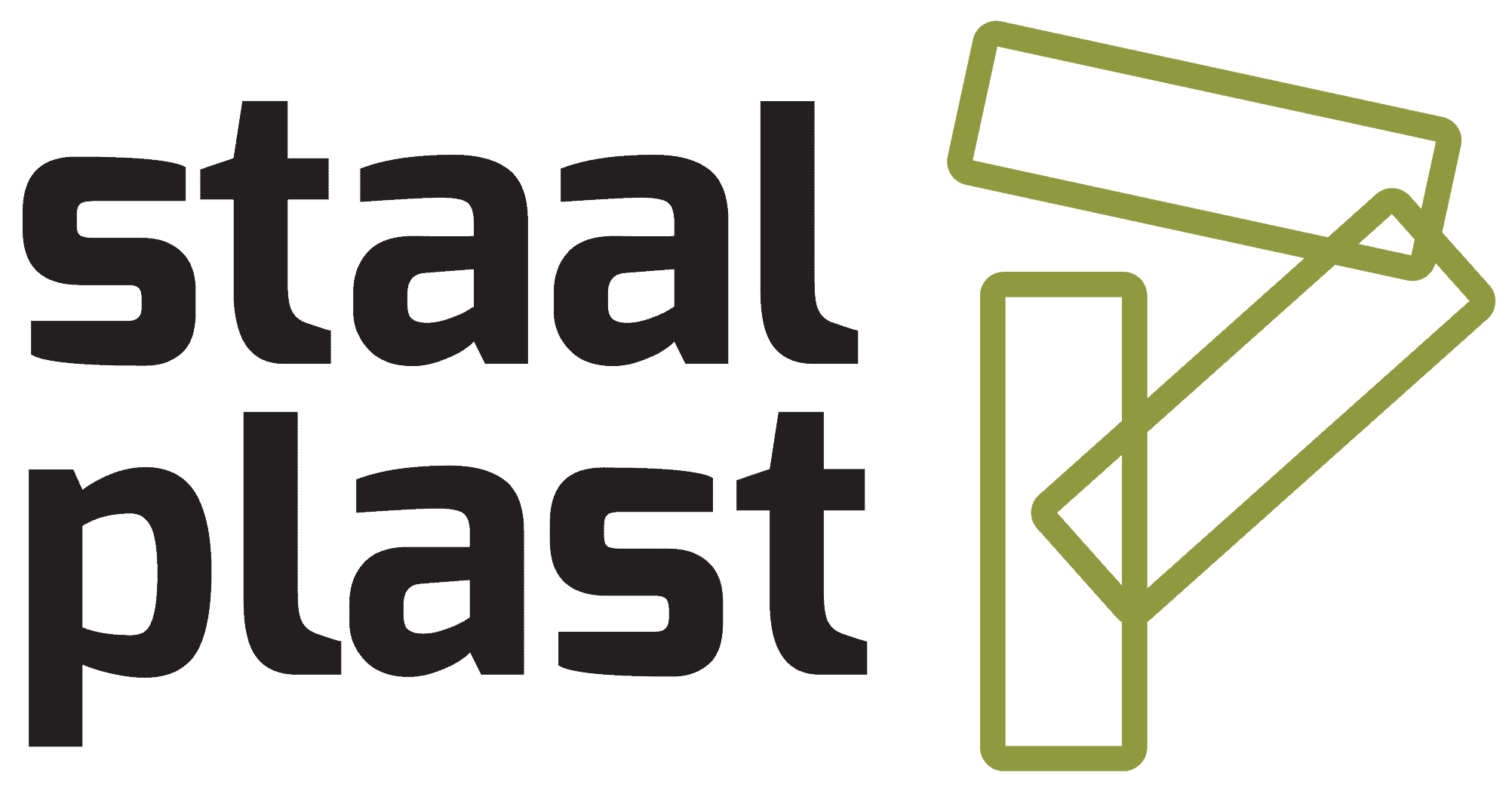Hydroponic Systems
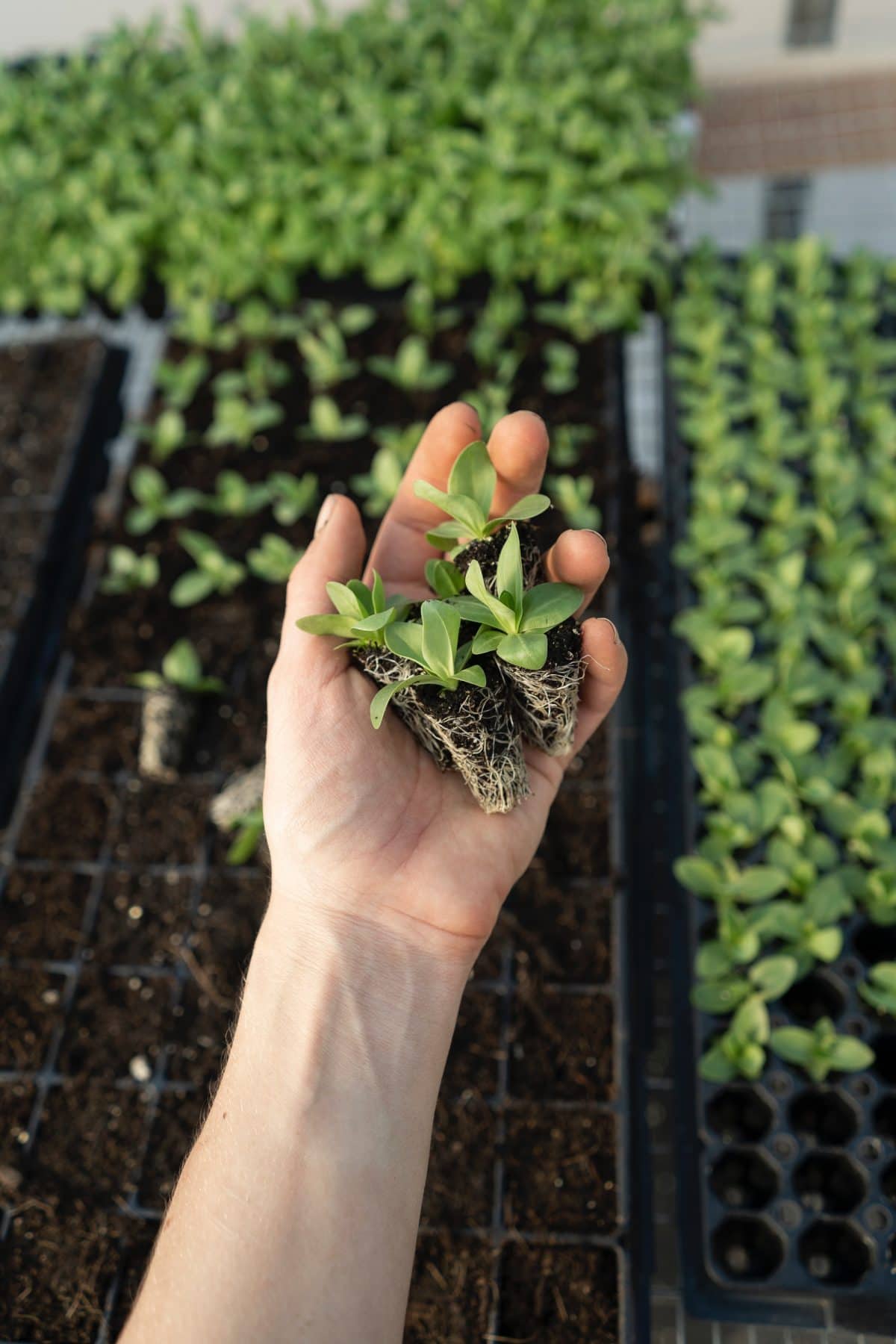
Hydroponic systems have revolutionized the way we cultivate plants by providing an efficient and innovative alternative to traditional soil-based agriculture. With hydroponics, plants are grown in a nutrient-rich water solution, allowing for optimized growth, increased yields, and precise control over environmental conditions. In this blog post, we will explore what hydroponic systems are and the numerous benefits they offer.
What are Hydroponic Systems?
Hydroponic systems are innovative methods of plant cultivation that eliminate the need for soil. Instead, plants are grown in a controlled environment using a water-based nutrient solution. This solution contains all the essential minerals and nutrients required for plant growth, ensuring optimal nourishment.
In hydroponics, the roots of the plants are directly exposed to the nutrient solution, allowing for efficient absorption of nutrients. To support the plants, various inert growing media such as perlite, coconut coir, or Rockwool are used to provide stability and aeration. The plants can be grown in containers, trays, or vertical systems, depending on the chosen hydroponic technique.
One of the key advantages of hydroponic systems is the precise control they offer over environmental factors. Parameters like light intensity, temperature, humidity, and nutrient composition can be fine-tuned to create an ideal growing environment. This level of control allows for accelerated plant growth, increased yields, and the ability to grow crops in any season.
Types of hydroponic systems
There are several different types of hydroponic systems, each with its own unique characteristics. Some of the most common types of hydroponic systems include:
Ebb and Flow Systems
The Ebb and Flow system is a hydroponic system that uses periodic flooding and draining of nutrient solution to provide water and nutrients to plants. In an Ebb and Flow system, plants sitting in pots filled with soil, perlite or coconut coir are placed in trays or containers. The nutrient solution is temporarily flooded into the tray, saturating the growing medium and providing water and nutrients to the plant roots. After a set period, the excess solution drains back into a reservoir, allowing the roots to access oxygen. This cyclic process of flooding and draining is controlled by a timer or automated system. Ebb and Flow systems are popular due to their simplicity, versatility, and ability to mimic natural irrigation cycles.
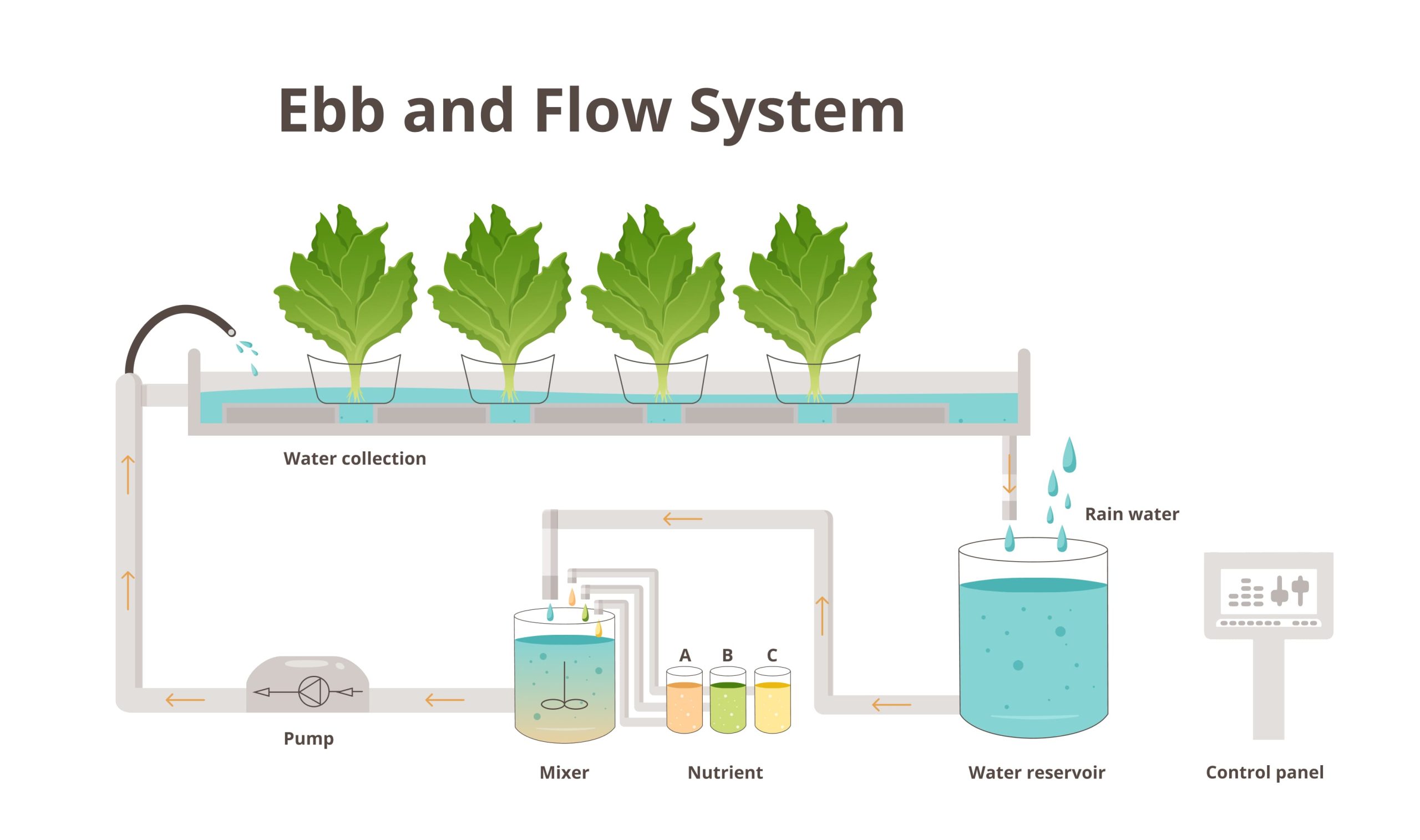
Nutrient Film Technique (NFT)
The Nutrient Film Technique (NFT) is a hydroponic system where a thin film of nutrient-rich water flows over the plant roots. The roots are suspended in a sloping tray or gutter, allowing for continuous nutrient absorption and oxygenation. This technique is simple to set up and maintain, conserves water, and is suitable for growing plants with shallow root systems like leafy greens and herbs.
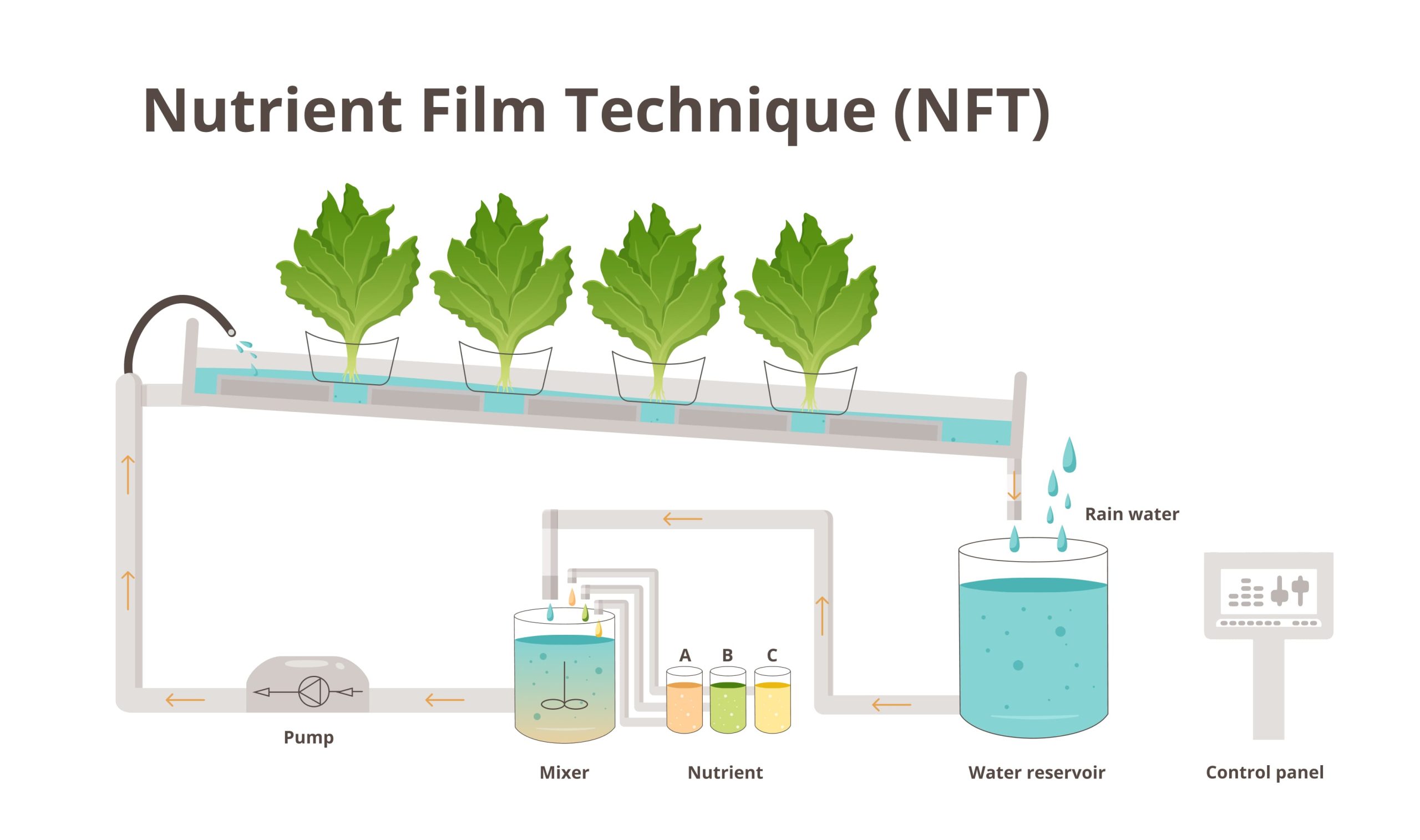
Deep Water Culture (DWC)
Deep Water Culture (DWC) is a hydroponic system where plant roots are submerged in a nutrient solution. The plants are typically supported by floating platforms or net pots, allowing their roots to access the oxygen-rich solution. DWC is easy to set up and maintain, promotes efficient nutrient uptake, and is commonly used for cultivating various plants, especially leafy greens such as spinach, lettuce or kale.
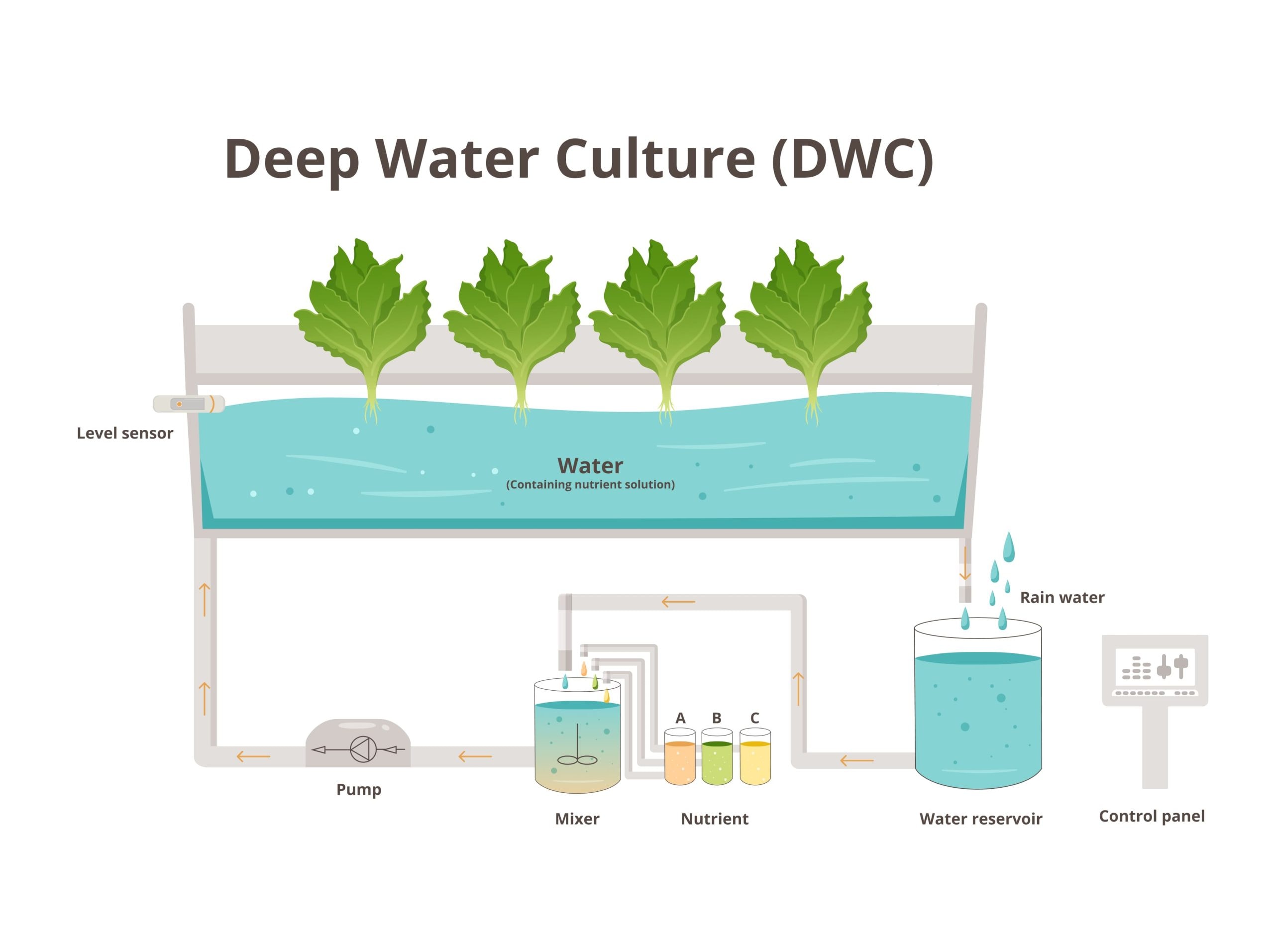
Wick System
The Wick System is a passive hydroponic system that uses a wick to deliver nutrient solution to the plant roots. The plant is placed in an inert growing medium, and a wick, usually made of a porous material like cotton or felt, connects the nutrient solution reservoir to the growing medium. The wick acts as a conduit, drawing the solution up to the roots through capillary action. The Wick System is easy to set up, requires no electricity or pumps, and is suitable for small-scale or low-maintenance hydroponic setups.
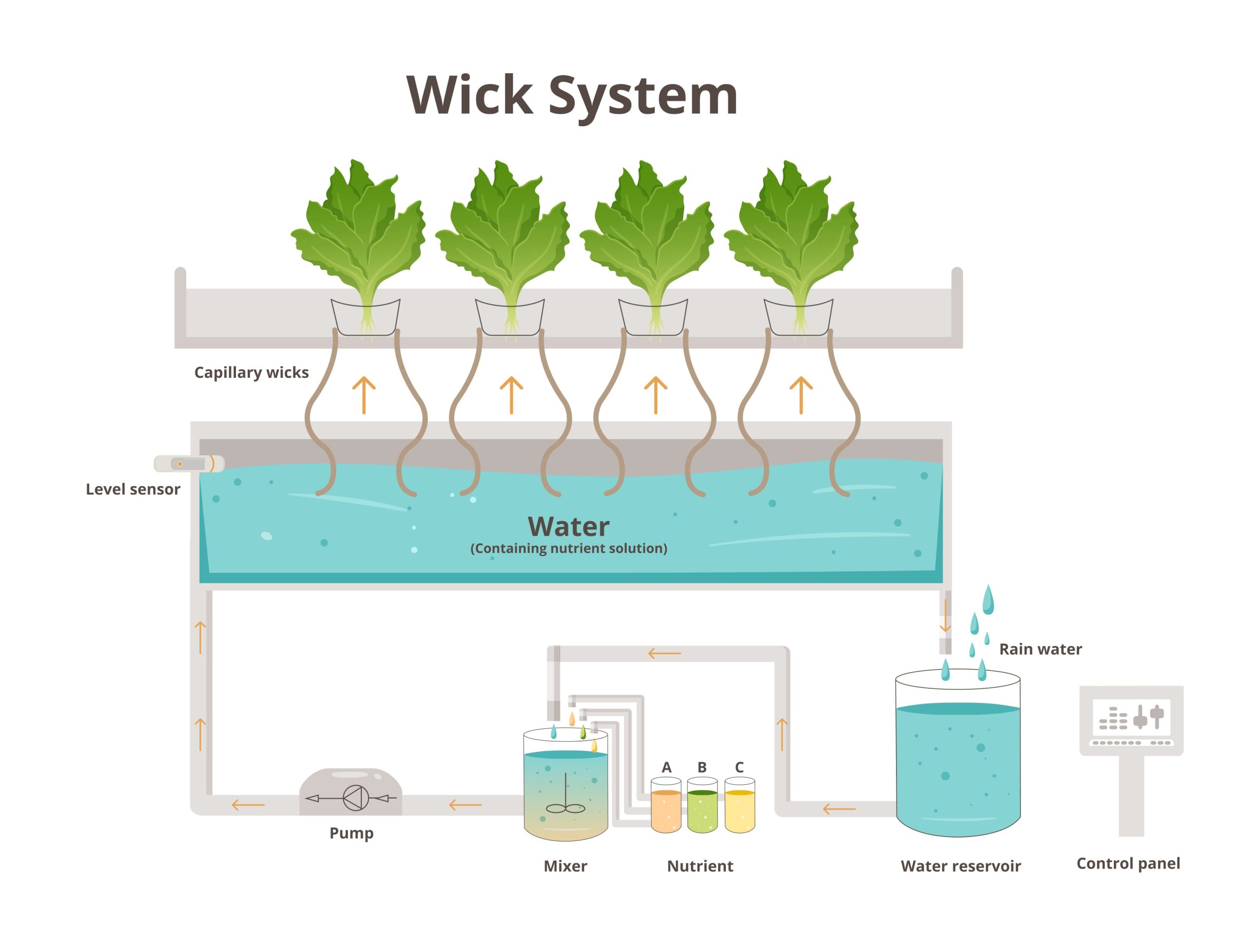
Drip Irrigation Systems
Drip irrigation systems deliver water directly to the plant roots through a network of tubing and emitters. These systems provide a slow and steady drip of water, allowing for precise and targeted watering. The emitters are strategically placed near the plants, ensuring that water is delivered directly to the root zone, minimizing evaporation and runoff. Drip irrigation systems are efficient in water usage as they provide controlled irrigation, reduce weed growth, and promote healthier plant growth. They are commonly used in gardens, farms, and landscapes to conserve water and optimize irrigation practices. Moreover, due to their unique properties, drip irrigation systems are a popular choice for cannabis cultivation.
In a drip irrigation system, the products from Staal & Plast are often used to collect and reuse the water originating from the drip irrigation system making it an even more sustainable process.
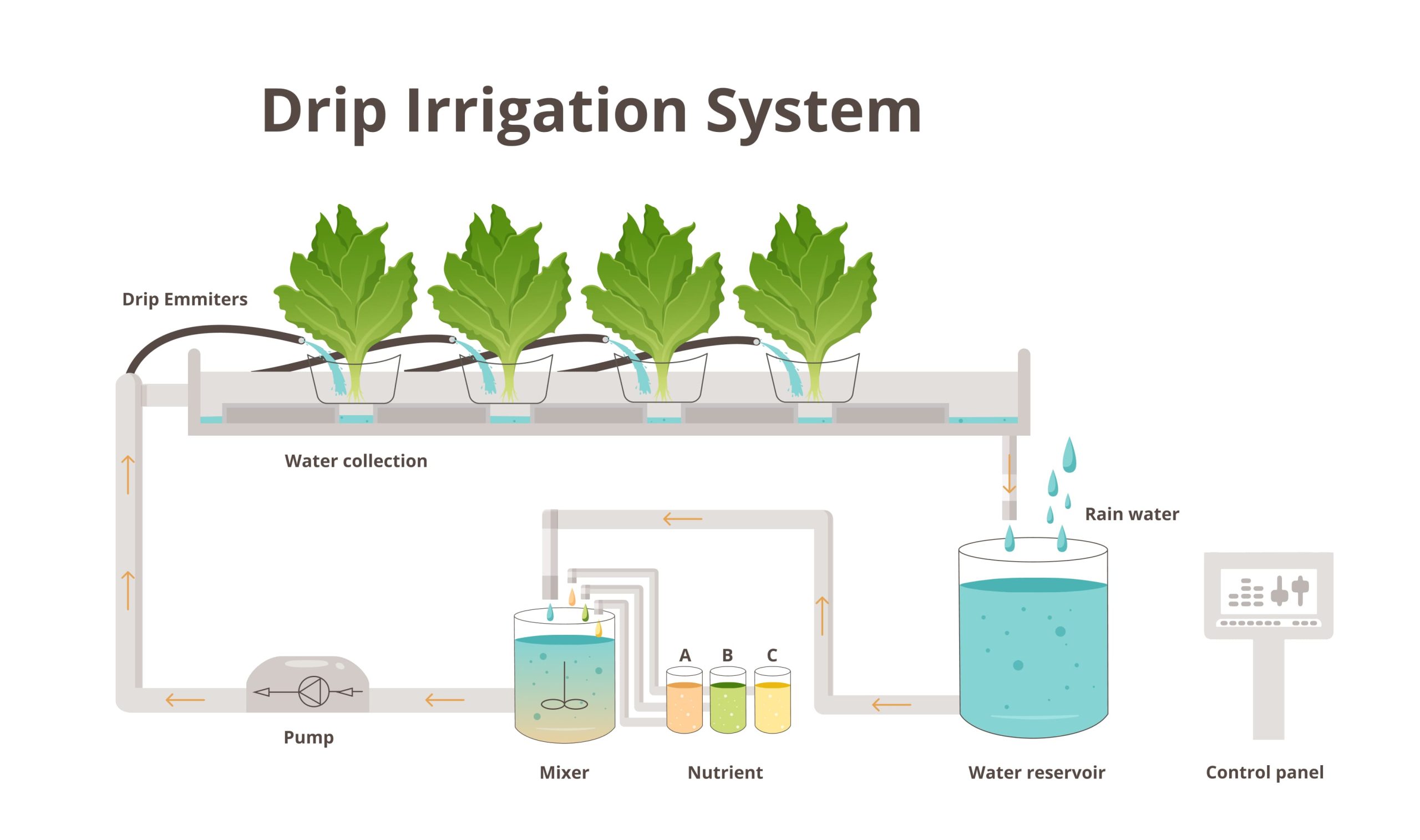
Aeroponic Systems
Aeroponic systems are advanced hydroponic systems where plant roots are suspended in air, and nutrient-rich water is delivered as a fine mist or spray. The plants are typically supported by a structure that holds the roots in place, allowing them to access the nutrient solution. The misting or spraying of the solution ensures direct contact with the roots, promoting efficient nutrient absorption. Aeroponic systems offer rapid plant growth, efficient nutrient usage, and optimal oxygenation of the roots. They are commonly used for cultivating delicate plants, microgreens, and high-value crops.
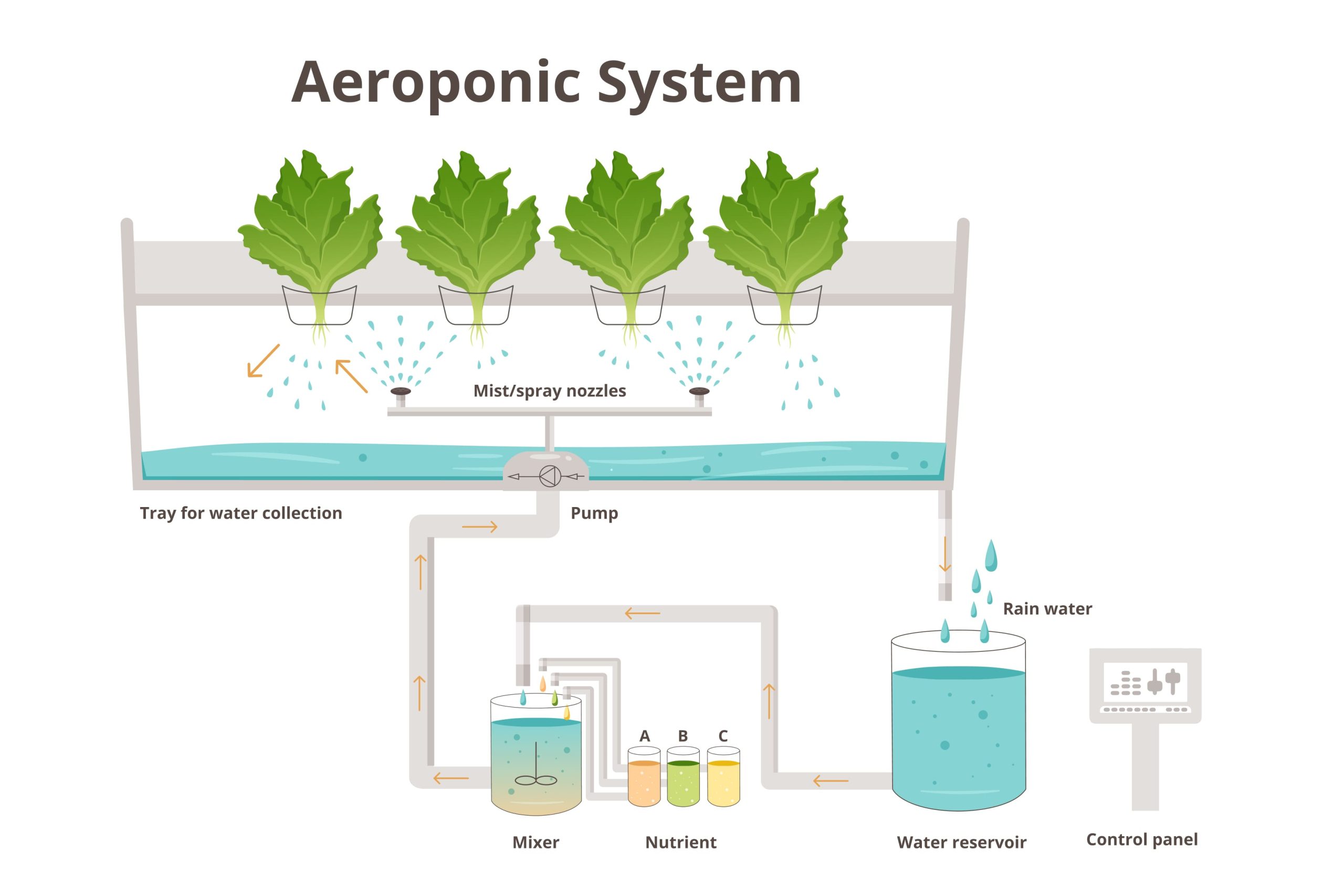
Vertical Hydroponic Systems
Vertical hydroponic systems are innovative setups where plants are grown vertically, stacked on multiple levels. These systems utilize a combination of hydroponic techniques such as Ebb and Flood, nutrient film technique (NFT) or deep water culture (DWC) to provide optimal growing conditions for plants. By utilizing vertical space, these systems maximize the use of limited land or indoor areas. Vertical hydroponic systems offer high crop yields, and year-round cultivation capabilities, making them suitable for urban farming and maximizing production in limited spaces.
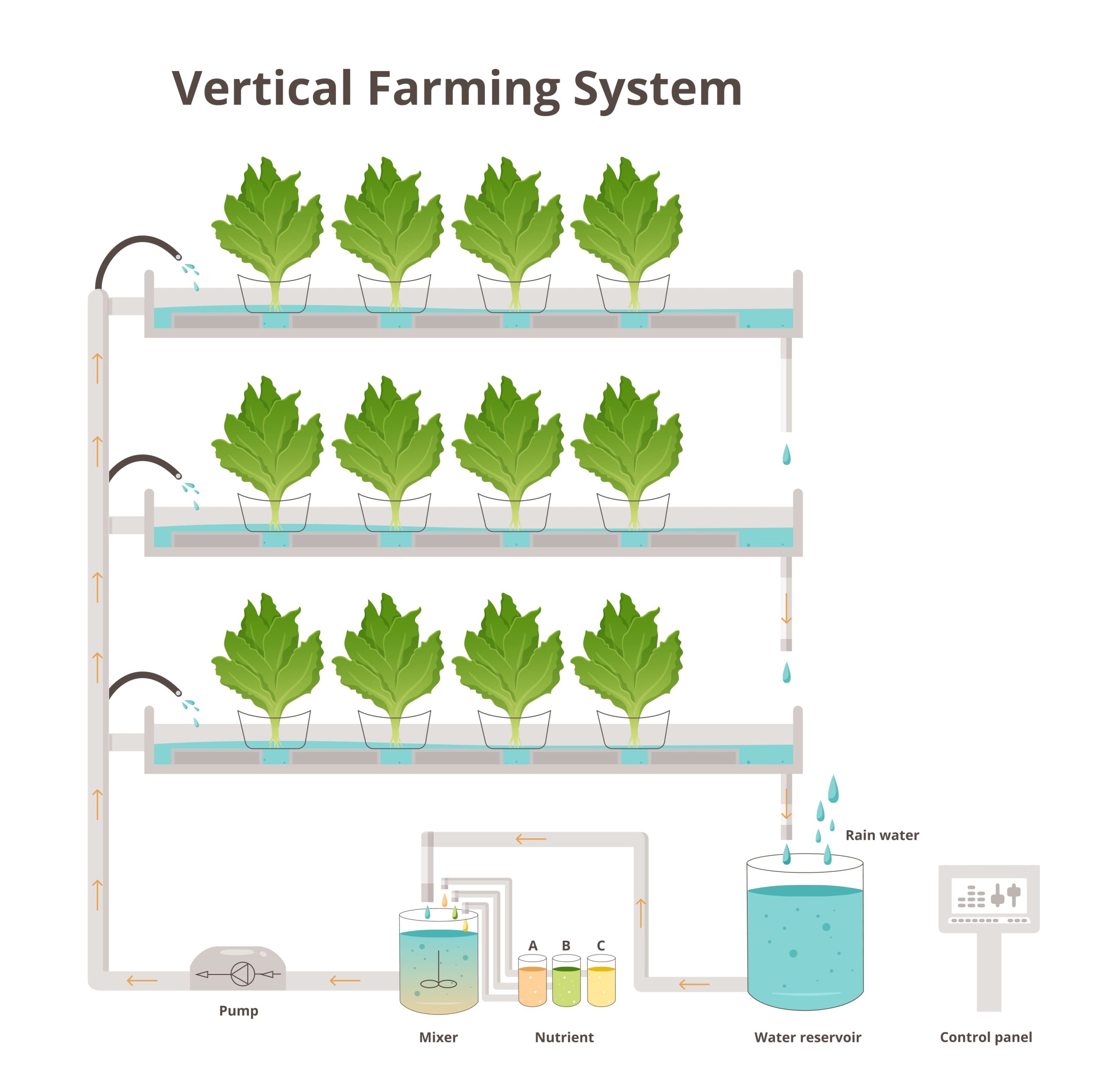
Choosing the Right Hydroponic System
Choosing the right hydroponic system requires careful consideration of several factors. Here are some key points to help you make an informed decision:
Decide on your plant selection
Consider the types of plants you intend to grow. Different plants have varying root structures and growth requirements. Some hydroponic systems are better suited for shallow-rooted plants like lettuce, while others can accommodate deep-rooted plants like tomatoes or peppers.
Consider your space availability
Consider the amount of space you have available for your hydroponic setup. For limited space you may consider a vertical hydroponic system whereas the Nutrient Film Technique (NFT) hydroponic system typically requires more space compared to other hydroponic systems.
Consider your water and nutrient management
Before investing in a hydroponic system, it is crucial to carefully consider water and nutrient management. Here are a few key points to keep in mind:
Water Quality
Assess the quality of your water source. The purity and pH of the water can have a significant impact on the success of your hydroponic system. Test your water for pH, mineral content, and contaminants to ensure it meets the requirements for hydroponic cultivation. If needed, invest in water treatment methods such as filtration or pH adjustment to optimize the water quality.
Nutrient Solution
Understand the composition and requirements of the nutrient solution for your chosen plants. Different plants have varying nutrient needs at different growth stages. Ensure you have a reliable source of quality hydroponic nutrients and understand how to properly mix and maintain the nutrient solution. Regularly monitor and adjust nutrient levels to prevent deficiencies or toxicities.
pH Management
pH plays a critical role in nutrient availability to plants. Most plants thrive in slightly acidic to neutral pH ranges. Invest in a pH testing kit and adjust the pH of your nutrient solution to the appropriate range for your plants. Regularly monitor and maintain the pH levels to avoid nutrient imbalances and potential plant health issues.
Watering Schedule
Develop a watering schedule that suits the specific needs of your plants and the hydroponic system you choose. Factors such as plant size, growth stage, temperature, and humidity influence the frequency and duration of watering. Strive for a balance between providing sufficient moisture to the roots while avoiding waterlogging. Automating the watering process with timers or employing techniques like drip irrigation can help ensure consistency and efficiency.
Nutrient Monitoring
Implement a system for monitoring nutrient levels in the solution. Regularly test the nutrient solution using appropriate tools to ensure that plants are receiving the optimal balance of essential minerals. Nutrient monitoring allows you to identify any imbalances or deficiencies early on and make necessary adjustments to maintain healthy plant growth.
System Maintenance
Proper maintenance of your hydroponic system is essential for water and nutrient management. Regularly clean and sanitize the system components to prevent the buildup of algae, pathogens or mineral deposits that can affect water quality and nutrient absorption. Inspect and maintain equipment such as pumps, filters, and irrigation systems to ensure their optimal functioning.
In general, considering water and nutrient management is crucial for the success of your hydroponic venture. By understanding the water quality, mastering nutrient solution preparation, managing pH levels, developing an appropriate watering schedule, monitoring nutrient levels, and maintaining the system, you can create an optimal growing environment that supports healthy plant growth and maximizes your hydroponic yields.
Consider the efficiency of resource utilization
When considering the efficiency of resource utilization in hydroponics, here are some important factors to keep in mind:
Water Efficiency
Evaluate the water requirements of different hydroponic systems. Look for systems that minimize water consumption by delivering water directly to the roots or utilizing recirculating systems. Consider water-saving techniques such as using timers, sensors, or drip irrigation to ensure efficient water usage. Additionally, explore water recycling or rainwater harvesting methods to further enhance water efficiency.
Nutrient Efficiency
Choose nutrient solutions that are specifically formulated for hydroponic use. These solutions are designed to provide the necessary nutrients in optimal ratios for plant growth. Follow recommended guidelines for nutrient concentrations and adjust as needed based on plant requirements. Regularly monitor nutrient levels and pH to prevent wastage and ensure efficient nutrient uptake by the plants.
Energy Efficiency
Consider the energy requirements of your hydroponic system. Opt for energy-efficient equipment, such as LED grow lights, which consume less electricity compared to traditional lighting systems. Utilize timers or automated controls to regulate lighting and irrigation cycles and avoid unnecessary energy consumption. Additionally, explore renewable energy sources such as solar panels to power your system, further enhancing energy efficiency.
Crop Selection
Select crops that are well-suited for hydroponic cultivation. Certain plants, such as leafy greens and herbs, tend to thrive in hydroponic systems and have high yields. By choosing crops that have a natural affinity for hydroponics, you can maximize resource efficiency and achieve better overall results.
Monitoring and Management
Regularly monitor and manage your hydroponic system to ensure optimal resource utilization. This includes monitoring water levels, nutrient concentrations, pH levels, and overall system health. Implementing automated monitoring systems or using digital tools can aid in efficient resource management by providing real-time data and alerts for timely adjustments.
Consider your budget
When considering your budget for a hydroponic system, there are several aspects to take into account:
Initial Investment
Assess the upfront costs associated with setting up the hydroponic system. This includes purchasing equipment such as grow lights, containers, pumps, nutrient solutions, pH meters, and other necessary components. Research different options and compare prices to find a system that fits within your budget.
Infrastructure Costs
Consider any infrastructure modifications or investments required for your hydroponic setup. This may include setting up a dedicated space with proper ventilation, electrical outlets, plumbing connections, or installing a greenhouse or grow tent. Take into account any additional costs associated with these infrastructure requirements.
Operational Expenses
Evaluate the ongoing operational expenses associated with running a hydroponic system. This includes costs for electricity to power lights, pumps, or climate control systems, as well as the regular purchase of nutrient solutions, growing media, and other consumables. Factor in these recurring expenses to understand the long-term financial commitment.
Maintenance and Upkeep
Budget for the maintenance and upkeep of your hydroponic system. This may include routine cleaning, replacement of worn-out components, calibration of pH and nutrient meters, and general repairs. Consider the time, effort, and costs involved in maintaining the system to ensure its optimal functioning.
Return on Investment (ROI)
Assess the potential return on investment (ROI) from your hydroponic system. Consider factors such as the crop yield, market prices for your produce, and the potential savings compared to purchasing similar produce from external sources. Calculate the potential financial benefits over time to gauge the ROI and determine the viability of your investment.
Scalability
Keep in mind the scalability of your hydroponic operation. If you plan to expand or increase production in the future, consider how your budget may need to accommodate additional equipment, infrastructure, or operational costs associated with scaling up your system.
By carefully considering your budget, you can make informed decisions about the initial investment, ongoing expenses, and potential returns from your hydroponic system. This allows you to plan and allocate your financial resources effectively, ensuring a sustainable and economically viable venture.
Benefits of Hydroponic Systems
Hydroponic systems have gained significant attention in the world of agriculture due to their numerous benefits and potential for sustainable food production. By providing an alternative to traditional soil-based farming, hydroponics offers unique advantages that can revolutionize the way we grow crops. From water efficiency and increased crop yield to space utilization and reduced environmental impact, hydroponic systems are transforming the landscape of modern agriculture. In this section, we will explore some of the key benefits of hydroponic systems, shedding light on why this innovative approach to cultivation is garnering attention and gaining popularity worldwide. Here are some of the main benefits of hydroponic systems:
Water Efficiency
Hydroponic systems use up to 90% less water compared to traditional soil-based agriculture. Water is recirculated within the system, minimizing wastage and allowing for efficient nutrient absorption by plants.
Increased Crop Yield
Hydroponic systems provide optimal growing conditions, allowing plants to grow faster and produce higher yields compared to traditional farming methods. By controlling factors such as nutrient delivery, lighting, and climate, hydroponics maximizes the growth potential of plants.
Year-Round Cultivation
Hydroponic systems enable year-round cultivation regardless of seasonal limitations. With controlled environments, growers can manipulate temperature, light cycles, and other conditions to create optimal growing conditions throughout the year.
Space Efficiency
Hydroponic systems are designed to maximize space utilization. Vertical hydroponics, in particular, allows for stacking plants vertically, making efficient use of limited floor space. This is especially advantageous in urban areas or areas with limited land availability.
Reduced Pesticide Use
Hydroponic systems are less prone to pest infestations compared to traditional soil-based farming. The controlled environment reduces the need for pesticides, making hydroponics a more environmentally friendly and sustainable method of cultivation.
Flexibility in Location
Hydroponic systems can be set up in various locations, including urban areas, rooftops, or indoor spaces. This flexibility allows for local food production, reducing the carbon footprint associated with transportation and enabling fresh produce to be grown closer to consumers.
Consistent Crop Quality
With precise control over nutrient delivery, lighting, and environmental conditions, hydroponic systems produce consistent crop quality. This is especially important for commercial growers aiming to supply high-quality produce to markets or restaurants.
Reduced Soil Erosion and Environmental Impact
Hydroponics eliminates the need for soil, reducing soil erosion and degradation. It also reduces the risk of nutrient leaching and runoff, minimizing the environmental impact on nearby water bodies.
Efficient Nutrient Delivery
Hydroponic systems deliver nutrients directly to the plant roots, ensuring efficient absorption and minimizing nutrient wastage. This results in healthier plants and improved nutrient utilization.
Educational Opportunities
Hydroponics offers educational opportunities for students and researchers to study plant growth, nutrient management, and sustainable agricultural practices. It provides a hands-on learning experience and promotes innovation in the field of agriculture.
